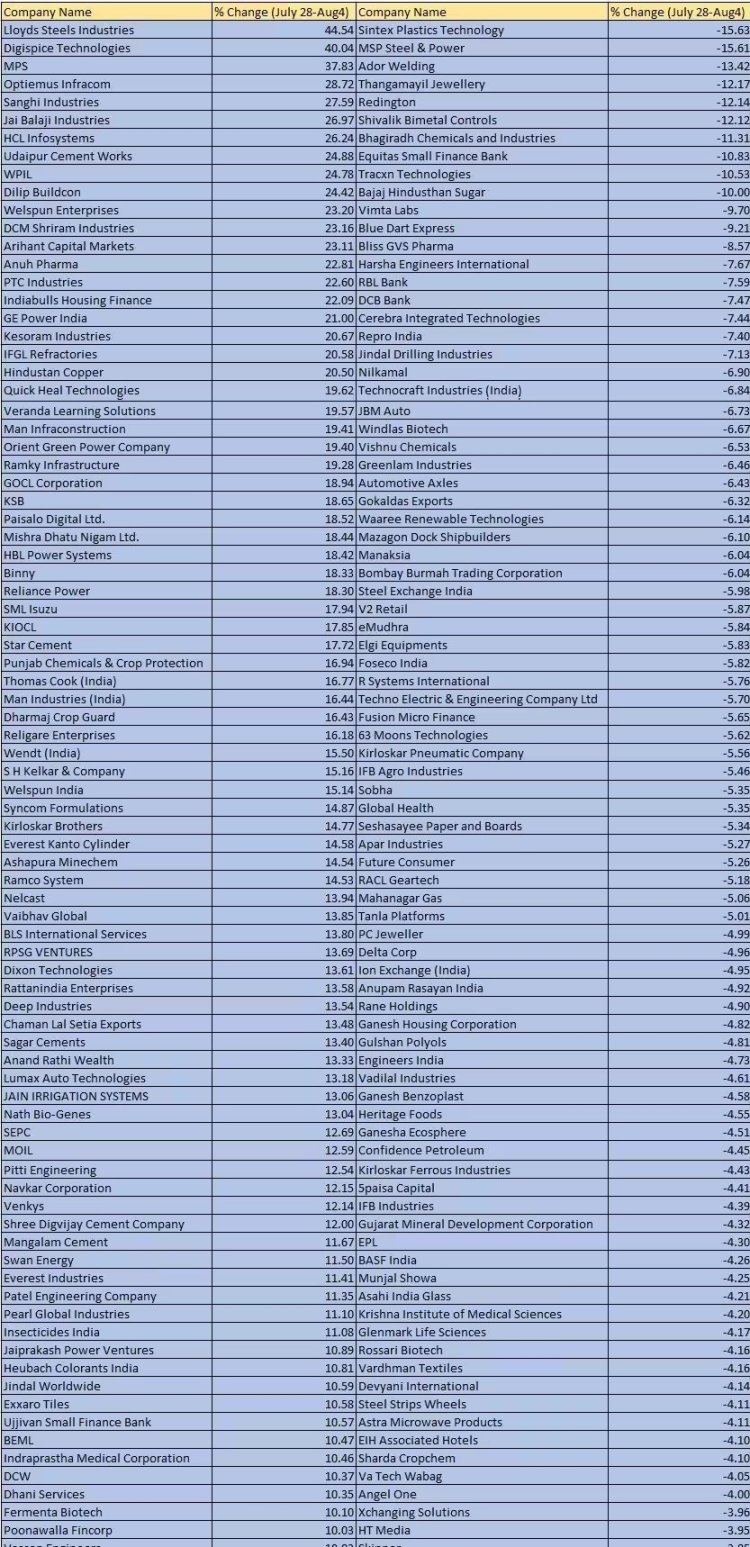Market extends losses, but these 85 small-caps give double-digit returns
Market optimism requires a move over 19,600 and calm international conditions. The markets are ambiguous. Experts advise vigilance at all times.

Foreign institutional investors (FIIs) sold off for a second week in a row in the week ending August 4. This was in response to a combination of sluggish global indicators, such as the downgrade of the US credit rating by rating agency Fitch, lacklustre factory activity data from China, and another interest rate hike by the Bank of England. Nonetheless, by the end of the week, investors' confidence had been restored because to better service statistics, buying by domestic institutional investors (DIIs), and a surplus monsoon.
This week, both the BSE Sensex (down 0.66 percent, or 438.95 points), and the Nifty50 (down 0.65 percent, or 129.05 points), finished at lower numbers than their previous weekly closing levels.
The BSE SmallCap Index increased by 1.5%, the BSE MidCap Index ended unchanged, and the BSE LargeCap Index decreased by 0.6%.
"The week started off on a hopeful note, with expectations that the policy-tightening era can come to an end as a result of falling inflation rates around the world. However, Vinod Nair, Head of Research at Geojit Financial Services, noted that "worries across the globe were triggered by negative news regarding the US rating downgrade, weak factory activity data from the Eurozone and China, and prolonged FII selling triggered by rising US bond yields."
"As fears about the state of the US economy grew, investors fled to the dollar in search of safety, sending the dollar index soaring. Nonetheless, domestic markets rebounded from the effect of weak global cues, with IT and healthcare sectors leading the way in terms of strong domestic results.
While manufacturing in India remained strong in July, it slowed for the second consecutive month. Conversely, thanks to an increase in new orders, especially from outside, the domestic service PMI surpassed market expectations and hit a 13-year high. Nair remarked, "Investors are waiting for the next MPC meeting to see if the RBI will maintain its policy rate at 6.5 percent."
The Nifty Realty index plummeted 4.2%, the Nifty PSU Bank index fell 4.0%, the Nifty FMCG index lost 1.7%, the Nifty IT index jumped 3.0%, and the Nifty Pharma index rose roughly 2%.
Lloyds Steels Industries, Digispice Technologies, MPS, Optiemus Infracom, Sanghi Industries, Jai Balaji Industries, HCL Infosystems, Udaipur Cement Works, WPIL, and Dilip Buildcon all contributed to a 1.5 percent increase in the BSE SmallCap index.

Bajaj Hindusthan Sugar, Equitas Small Finance Bank, Tracxn Technologies, Sintex Plastics Technology, MSP Steel & Power, Ador Welding, Thangamayil Jewellery, Redington, Shivalik Bimetal Controls, Bhagiradha Chemicals and Industries, and Sintex Plastics Technology all saw their share prices drop by 10-15%.
Nifty found some relief at the end of a turbulent week by climbing back above the 19,500 level. The IT sector sparked the recovery, but the BFSI sector, which was hit the worst, carried it ahead and restored optimism in the market. Keep in mind that we haven't made it through this ordeal unscathed. For the first time since March 31, 2023, we are technically positioned below the 20-day EMA (exponential moving average) for the Nifty. Therefore, unless the Nifty closes over 19,550-1,600, complacency is not warranted. Angel One's Head of Research, Technical and Derivatives, Sameet Chavan, advised, "It's best to avoid aggressive trades."
If there are further unusual events on a global scale, the Nifty could test the 19,400-19,300 zone again. If prices drop below this level, they could face more selling pressure and head towards the next key area between 19,000 and 18,800.
For the positive scenario to come to fruition, it is essential to get over 19,600, and all international trends must cease entirely. The market's mixed signals for the week's close suggest taking things slowly for the time being. Chavan also expressed hope that the present downturn would not be prolonged for too much longer, and that the fabled 20,000 mark would be reached soon.
While domestic institutional investors (DIIs) bought shares worth Rs 5,617.33 crore this week, foreign institutional investors (FIIs) sold shares worth Rs 3,545.64 crore.
Where is Nifty50 headed?
According to Rupak De, Senior Technical Analyst at LKP Securities, the Nifty dropped significantly after the US credit rating was lowered from AAA to AA+, resulting in a breakdown from the recent consolidation on the daily timeframe. The index has fallen below the 21-day EMA for the first time since March 29 due to the recent decline. 19 300 individuals served as immediate support. On the upside, however, 19,566 is likely to function as a significant resistance level.
As long as the Nifty stays below 19,566, sentiment is likely to remain negative. In contrast, a decisive rise above 19,566 could propel the index to 19,700–19,750. A failure to advance above 19,566 could trigger selling pressure, however.
According to Jatin Gedia, a Technical Research Analyst at Sharekhan by BNP Paribas, the Nifty was able to recoup some of its losses in the final trading session of the week, following severe selling throughout the week. On a weekly basis, however, it has closed in the red for the second week in a row. The pullback is likely to stall in the 19,560–19,600 range, where the 40-hour moving average and the hourly upper Bollinger band provide resistance. Therefore, this rebound should be marketed to.
Also Read : Government defers implementation of restrictions on imports of laptops, PCs and tablets to Nov 1
The hourly momentum indicator has also reached the equilibrium line, indicating that the retreat is complete and can commence a new downward cycle. Overall, the trajectory remains negative, and we anticipate levels of 19,100 in the near future, he added.
The Bank Nifty has also experienced a decline. It is unlikely, however, to result in a larger trend reversal. The pullback is likely to end in the 45,100–45,200 range, where the 40-hour moving average and the hourly upper Bollinger band provide resistance. The hourly momentum indicator has recorded a retracement to the equilibrium line, indicating that the retracement has reached completion and can now initiate a new cycle. Overall, the trajectory is still negative, and we anticipate a short-term decline to 44,000.
Disclaimer: The opinions and investment advice expressed by Moneypoise.com's experts are their own and do not reflect the views of the website or its management. Before making investment decisions, Moneypoise.com recommends that users consult with certified experts.














.jpeg?updatedAt=1698674282372)





